Business Research Project: Marketing Innovation at Lycamobile UK
VerifiedAdded on 2020/05/28
|100
|20517
|164
Project
AI Summary
This business research project investigates the impact of marketing innovation on attracting new customers, using Lycamobile UK as a case study. The research explores the importance of marketing innovation in a globalized market, where competition is high and similar products are offered by various organizations. The study aims to understand the concept of marketing innovation, analyze its role in attracting new customers, evaluate the factors influencing customer buying decisions, and provide recommendations for improving marketing strategies. The project includes a literature review of relevant models and theories, a detailed methodology section outlining the research philosophy, approach, design, and strategy. The research employs a survey strategy for data collection and utilizes SPSS for quantitative data analysis. The findings are presented in the analysis and findings chapter, followed by conclusions, recommendations, and suggestions for future research, all contributing to a comprehensive understanding of marketing innovation's role in customer acquisition within the telecommunications industry.
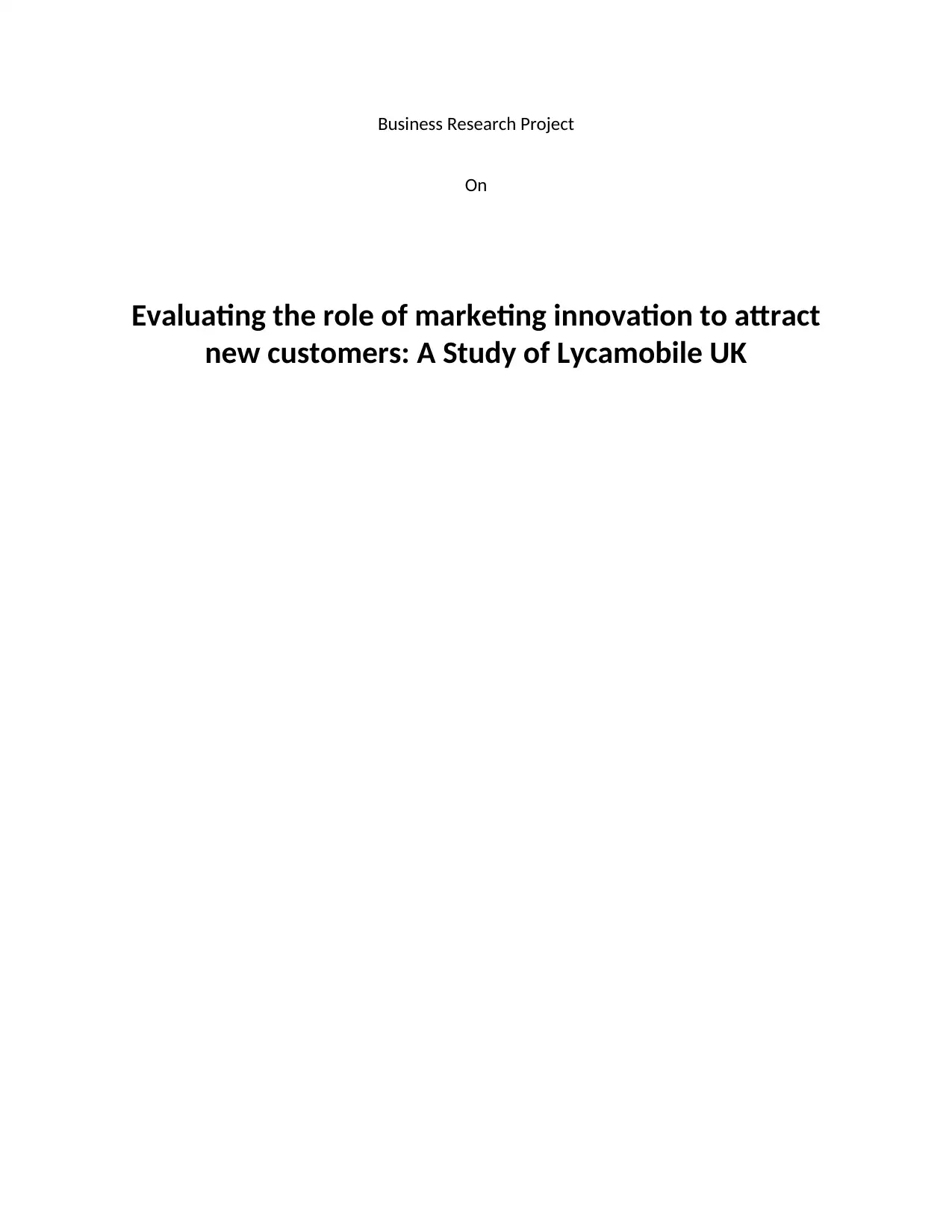
Business Research Project
On
Evaluating the role of marketing innovation to attract
new customers: A Study of Lycamobile UK
On
Evaluating the role of marketing innovation to attract
new customers: A Study of Lycamobile UK
Paraphrase This Document
Need a fresh take? Get an instant paraphrase of this document with our AI Paraphraser
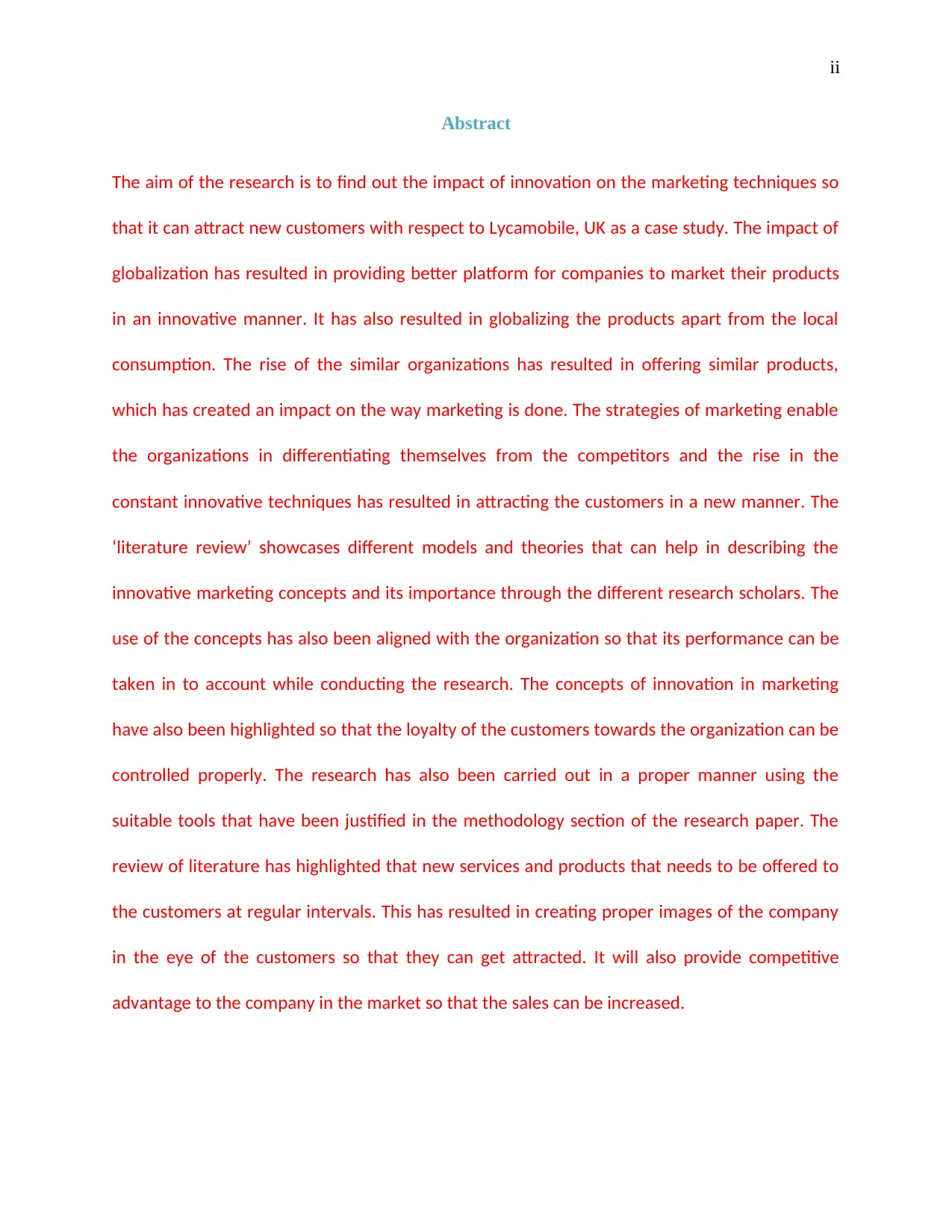
ii
Abstract
The aim of the research is to find out the impact of innovation on the marketing techniques so
that it can attract new customers with respect to Lycamobile, UK as a case study. The impact of
globalization has resulted in providing better platform for companies to market their products
in an innovative manner. It has also resulted in globalizing the products apart from the local
consumption. The rise of the similar organizations has resulted in offering similar products,
which has created an impact on the way marketing is done. The strategies of marketing enable
the organizations in differentiating themselves from the competitors and the rise in the
constant innovative techniques has resulted in attracting the customers in a new manner. The
‘literature review’ showcases different models and theories that can help in describing the
innovative marketing concepts and its importance through the different research scholars. The
use of the concepts has also been aligned with the organization so that its performance can be
taken in to account while conducting the research. The concepts of innovation in marketing
have also been highlighted so that the loyalty of the customers towards the organization can be
controlled properly. The research has also been carried out in a proper manner using the
suitable tools that have been justified in the methodology section of the research paper. The
review of literature has highlighted that new services and products that needs to be offered to
the customers at regular intervals. This has resulted in creating proper images of the company
in the eye of the customers so that they can get attracted. It will also provide competitive
advantage to the company in the market so that the sales can be increased.
Abstract
The aim of the research is to find out the impact of innovation on the marketing techniques so
that it can attract new customers with respect to Lycamobile, UK as a case study. The impact of
globalization has resulted in providing better platform for companies to market their products
in an innovative manner. It has also resulted in globalizing the products apart from the local
consumption. The rise of the similar organizations has resulted in offering similar products,
which has created an impact on the way marketing is done. The strategies of marketing enable
the organizations in differentiating themselves from the competitors and the rise in the
constant innovative techniques has resulted in attracting the customers in a new manner. The
‘literature review’ showcases different models and theories that can help in describing the
innovative marketing concepts and its importance through the different research scholars. The
use of the concepts has also been aligned with the organization so that its performance can be
taken in to account while conducting the research. The concepts of innovation in marketing
have also been highlighted so that the loyalty of the customers towards the organization can be
controlled properly. The research has also been carried out in a proper manner using the
suitable tools that have been justified in the methodology section of the research paper. The
review of literature has highlighted that new services and products that needs to be offered to
the customers at regular intervals. This has resulted in creating proper images of the company
in the eye of the customers so that they can get attracted. It will also provide competitive
advantage to the company in the market so that the sales can be increased.
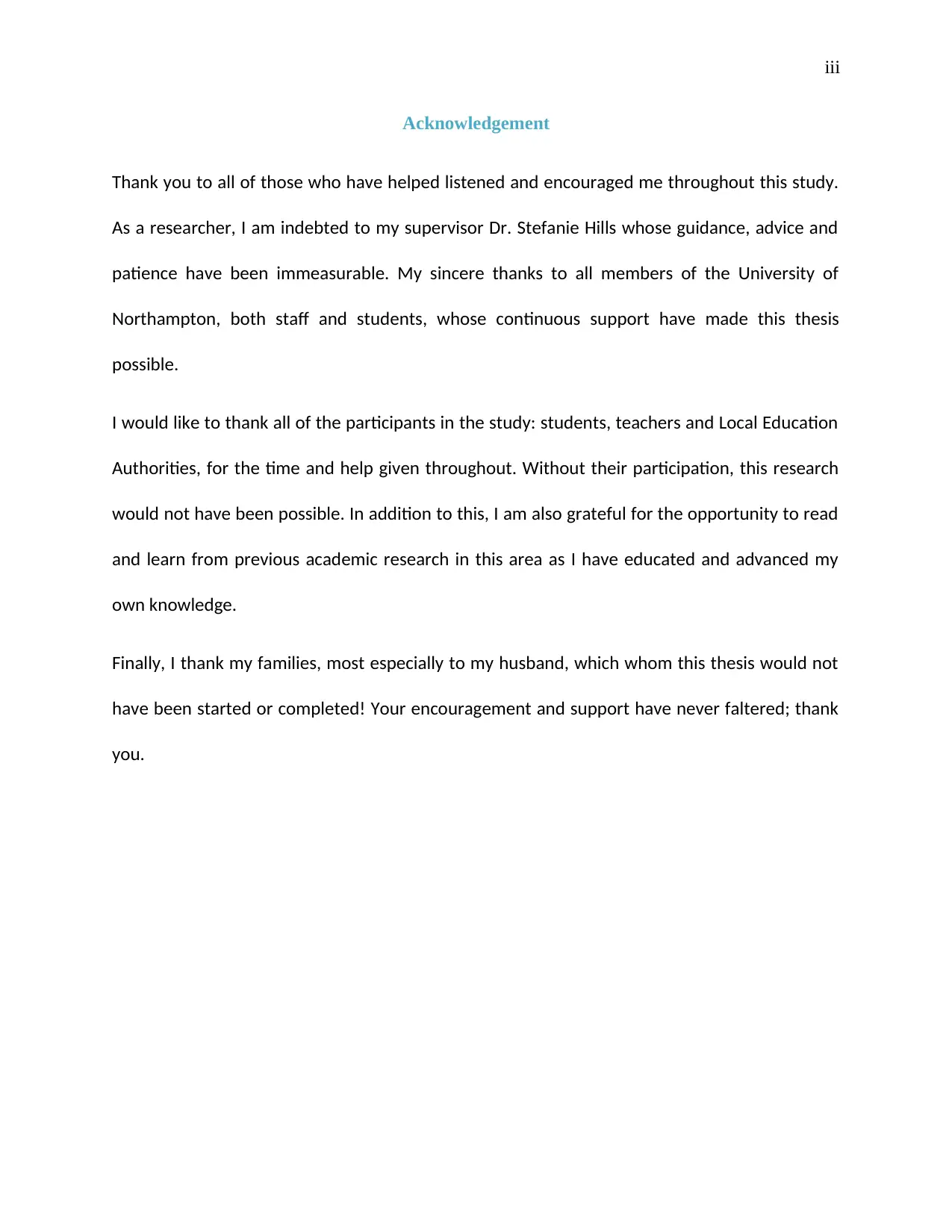
iii
Acknowledgement
Thank you to all of those who have helped listened and encouraged me throughout this study.
As a researcher, I am indebted to my supervisor Dr. Stefanie Hills whose guidance, advice and
patience have been immeasurable. My sincere thanks to all members of the University of
Northampton, both staff and students, whose continuous support have made this thesis
possible.
I would like to thank all of the participants in the study: students, teachers and Local Education
Authorities, for the time and help given throughout. Without their participation, this research
would not have been possible. In addition to this, I am also grateful for the opportunity to read
and learn from previous academic research in this area as I have educated and advanced my
own knowledge.
Finally, I thank my families, most especially to my husband, which whom this thesis would not
have been started or completed! Your encouragement and support have never faltered; thank
you.
Acknowledgement
Thank you to all of those who have helped listened and encouraged me throughout this study.
As a researcher, I am indebted to my supervisor Dr. Stefanie Hills whose guidance, advice and
patience have been immeasurable. My sincere thanks to all members of the University of
Northampton, both staff and students, whose continuous support have made this thesis
possible.
I would like to thank all of the participants in the study: students, teachers and Local Education
Authorities, for the time and help given throughout. Without their participation, this research
would not have been possible. In addition to this, I am also grateful for the opportunity to read
and learn from previous academic research in this area as I have educated and advanced my
own knowledge.
Finally, I thank my families, most especially to my husband, which whom this thesis would not
have been started or completed! Your encouragement and support have never faltered; thank
you.
⊘ This is a preview!⊘
Do you want full access?
Subscribe today to unlock all pages.

Trusted by 1+ million students worldwide
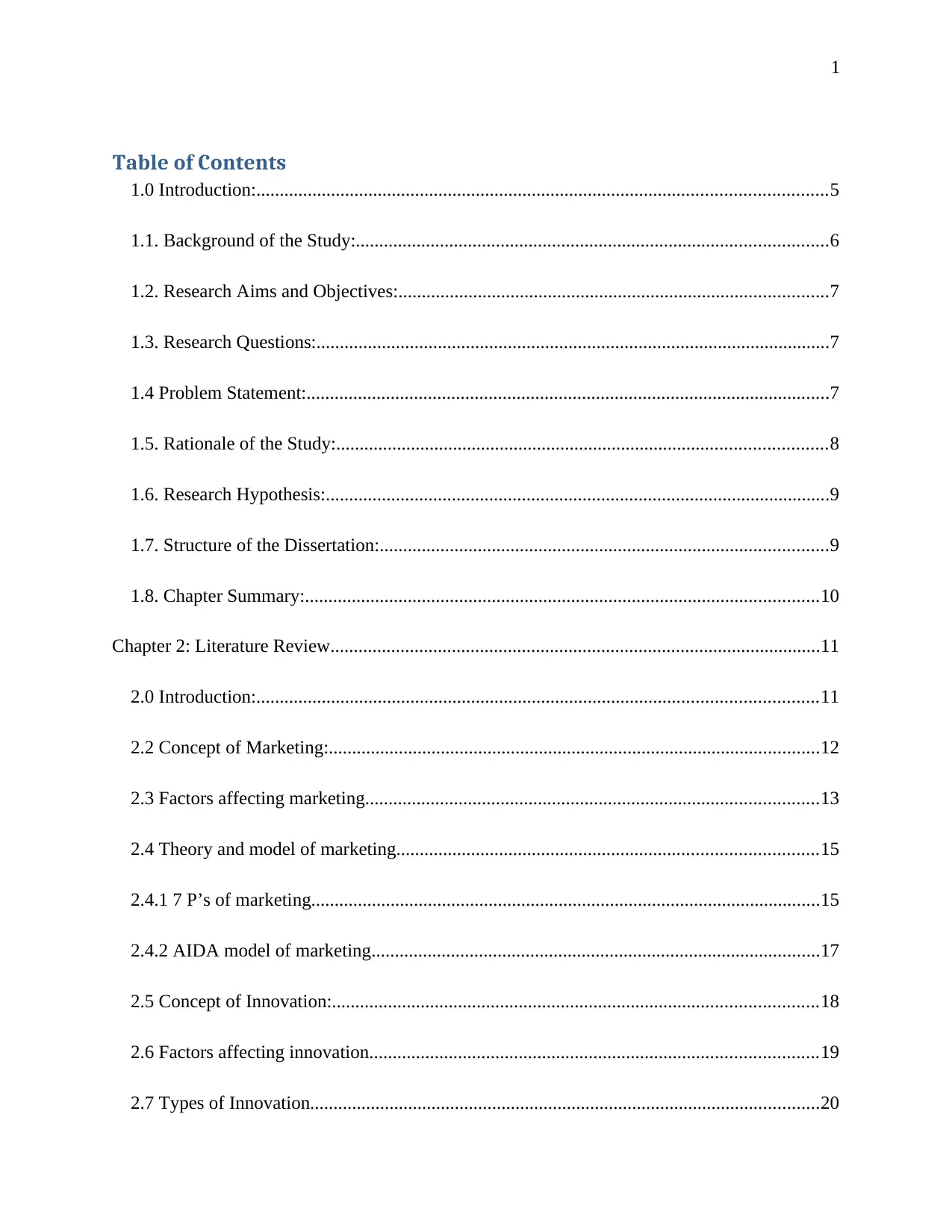
1
Table of Contents
1.0 Introduction:..........................................................................................................................5
1.1. Background of the Study:.....................................................................................................6
1.2. Research Aims and Objectives:............................................................................................7
1.3. Research Questions:..............................................................................................................7
1.4 Problem Statement:................................................................................................................7
1.5. Rationale of the Study:.........................................................................................................8
1.6. Research Hypothesis:............................................................................................................9
1.7. Structure of the Dissertation:................................................................................................9
1.8. Chapter Summary:..............................................................................................................10
Chapter 2: Literature Review.........................................................................................................11
2.0 Introduction:........................................................................................................................11
2.2 Concept of Marketing:.........................................................................................................12
2.3 Factors affecting marketing.................................................................................................13
2.4 Theory and model of marketing..........................................................................................15
2.4.1 7 P’s of marketing.............................................................................................................15
2.4.2 AIDA model of marketing................................................................................................17
2.5 Concept of Innovation:........................................................................................................18
2.6 Factors affecting innovation................................................................................................19
2.7 Types of Innovation.............................................................................................................20
Table of Contents
1.0 Introduction:..........................................................................................................................5
1.1. Background of the Study:.....................................................................................................6
1.2. Research Aims and Objectives:............................................................................................7
1.3. Research Questions:..............................................................................................................7
1.4 Problem Statement:................................................................................................................7
1.5. Rationale of the Study:.........................................................................................................8
1.6. Research Hypothesis:............................................................................................................9
1.7. Structure of the Dissertation:................................................................................................9
1.8. Chapter Summary:..............................................................................................................10
Chapter 2: Literature Review.........................................................................................................11
2.0 Introduction:........................................................................................................................11
2.2 Concept of Marketing:.........................................................................................................12
2.3 Factors affecting marketing.................................................................................................13
2.4 Theory and model of marketing..........................................................................................15
2.4.1 7 P’s of marketing.............................................................................................................15
2.4.2 AIDA model of marketing................................................................................................17
2.5 Concept of Innovation:........................................................................................................18
2.6 Factors affecting innovation................................................................................................19
2.7 Types of Innovation.............................................................................................................20
Paraphrase This Document
Need a fresh take? Get an instant paraphrase of this document with our AI Paraphraser
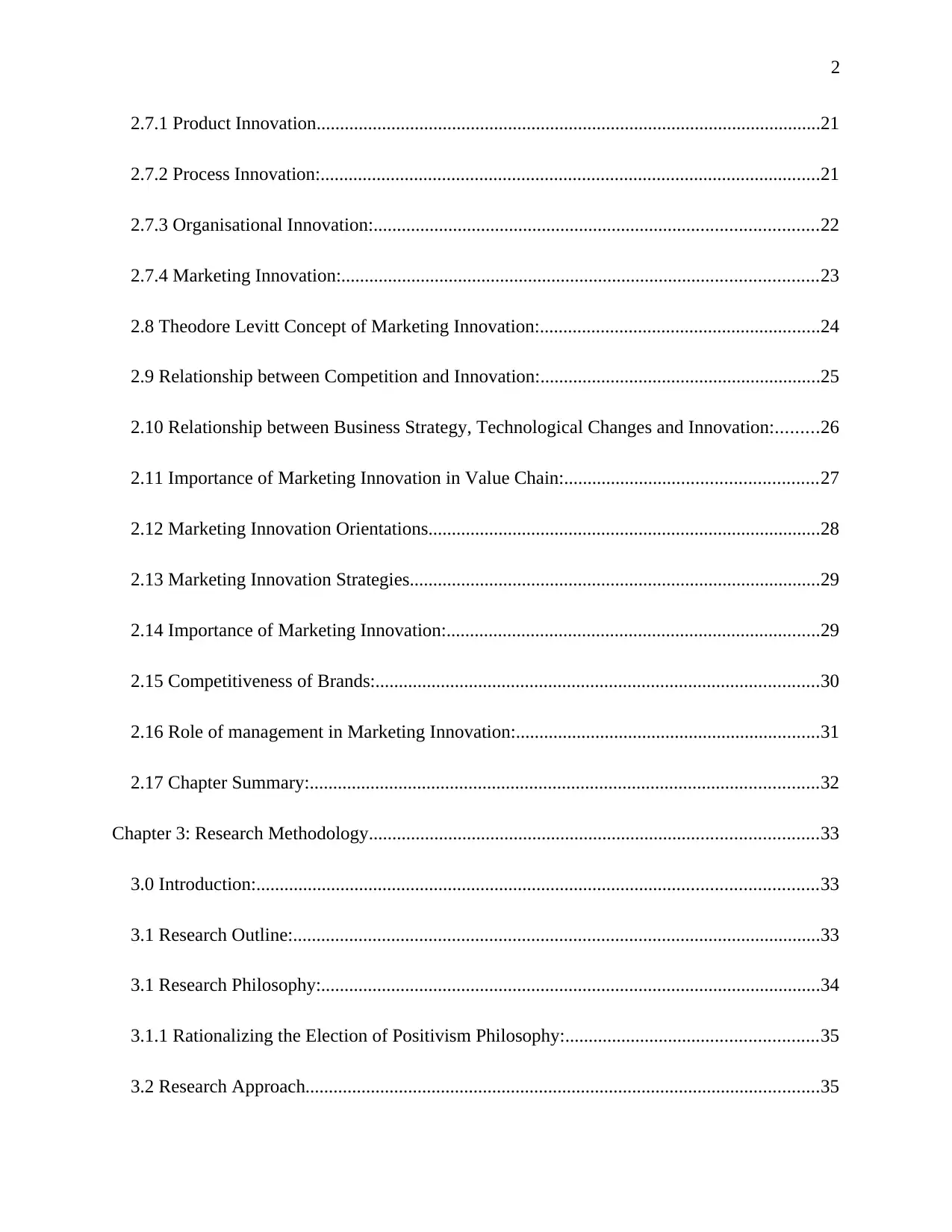
2
2.7.1 Product Innovation............................................................................................................21
2.7.2 Process Innovation:...........................................................................................................21
2.7.3 Organisational Innovation:...............................................................................................22
2.7.4 Marketing Innovation:......................................................................................................23
2.8 Theodore Levitt Concept of Marketing Innovation:............................................................24
2.9 Relationship between Competition and Innovation:............................................................25
2.10 Relationship between Business Strategy, Technological Changes and Innovation:.........26
2.11 Importance of Marketing Innovation in Value Chain:......................................................27
2.12 Marketing Innovation Orientations....................................................................................28
2.13 Marketing Innovation Strategies........................................................................................29
2.14 Importance of Marketing Innovation:................................................................................29
2.15 Competitiveness of Brands:...............................................................................................30
2.16 Role of management in Marketing Innovation:.................................................................31
2.17 Chapter Summary:.............................................................................................................32
Chapter 3: Research Methodology................................................................................................33
3.0 Introduction:........................................................................................................................33
3.1 Research Outline:.................................................................................................................33
3.1 Research Philosophy:...........................................................................................................34
3.1.1 Rationalizing the Election of Positivism Philosophy:......................................................35
3.2 Research Approach..............................................................................................................35
2.7.1 Product Innovation............................................................................................................21
2.7.2 Process Innovation:...........................................................................................................21
2.7.3 Organisational Innovation:...............................................................................................22
2.7.4 Marketing Innovation:......................................................................................................23
2.8 Theodore Levitt Concept of Marketing Innovation:............................................................24
2.9 Relationship between Competition and Innovation:............................................................25
2.10 Relationship between Business Strategy, Technological Changes and Innovation:.........26
2.11 Importance of Marketing Innovation in Value Chain:......................................................27
2.12 Marketing Innovation Orientations....................................................................................28
2.13 Marketing Innovation Strategies........................................................................................29
2.14 Importance of Marketing Innovation:................................................................................29
2.15 Competitiveness of Brands:...............................................................................................30
2.16 Role of management in Marketing Innovation:.................................................................31
2.17 Chapter Summary:.............................................................................................................32
Chapter 3: Research Methodology................................................................................................33
3.0 Introduction:........................................................................................................................33
3.1 Research Outline:.................................................................................................................33
3.1 Research Philosophy:...........................................................................................................34
3.1.1 Rationalizing the Election of Positivism Philosophy:......................................................35
3.2 Research Approach..............................................................................................................35
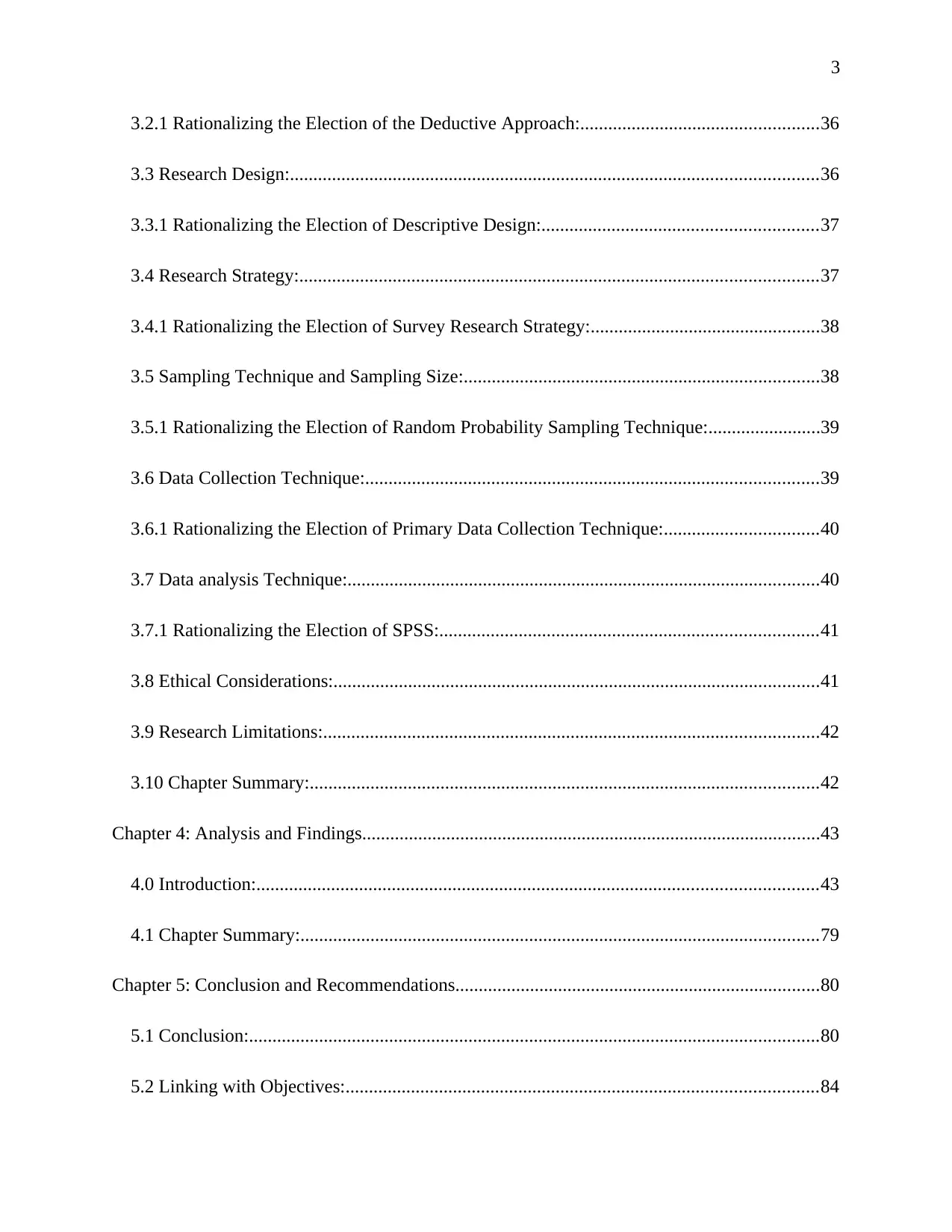
3
3.2.1 Rationalizing the Election of the Deductive Approach:...................................................36
3.3 Research Design:.................................................................................................................36
3.3.1 Rationalizing the Election of Descriptive Design:...........................................................37
3.4 Research Strategy:...............................................................................................................37
3.4.1 Rationalizing the Election of Survey Research Strategy:.................................................38
3.5 Sampling Technique and Sampling Size:............................................................................38
3.5.1 Rationalizing the Election of Random Probability Sampling Technique:........................39
3.6 Data Collection Technique:.................................................................................................39
3.6.1 Rationalizing the Election of Primary Data Collection Technique:.................................40
3.7 Data analysis Technique:.....................................................................................................40
3.7.1 Rationalizing the Election of SPSS:.................................................................................41
3.8 Ethical Considerations:........................................................................................................41
3.9 Research Limitations:..........................................................................................................42
3.10 Chapter Summary:.............................................................................................................42
Chapter 4: Analysis and Findings..................................................................................................43
4.0 Introduction:........................................................................................................................43
4.1 Chapter Summary:...............................................................................................................79
Chapter 5: Conclusion and Recommendations..............................................................................80
5.1 Conclusion:..........................................................................................................................80
5.2 Linking with Objectives:.....................................................................................................84
3.2.1 Rationalizing the Election of the Deductive Approach:...................................................36
3.3 Research Design:.................................................................................................................36
3.3.1 Rationalizing the Election of Descriptive Design:...........................................................37
3.4 Research Strategy:...............................................................................................................37
3.4.1 Rationalizing the Election of Survey Research Strategy:.................................................38
3.5 Sampling Technique and Sampling Size:............................................................................38
3.5.1 Rationalizing the Election of Random Probability Sampling Technique:........................39
3.6 Data Collection Technique:.................................................................................................39
3.6.1 Rationalizing the Election of Primary Data Collection Technique:.................................40
3.7 Data analysis Technique:.....................................................................................................40
3.7.1 Rationalizing the Election of SPSS:.................................................................................41
3.8 Ethical Considerations:........................................................................................................41
3.9 Research Limitations:..........................................................................................................42
3.10 Chapter Summary:.............................................................................................................42
Chapter 4: Analysis and Findings..................................................................................................43
4.0 Introduction:........................................................................................................................43
4.1 Chapter Summary:...............................................................................................................79
Chapter 5: Conclusion and Recommendations..............................................................................80
5.1 Conclusion:..........................................................................................................................80
5.2 Linking with Objectives:.....................................................................................................84
⊘ This is a preview!⊘
Do you want full access?
Subscribe today to unlock all pages.

Trusted by 1+ million students worldwide

4
5.3 Recommendations:..............................................................................................................86
5.4 Future scope of the Study:...................................................................................................87
5.5 Summary:.............................................................................................................................88
References......................................................................................................................................90
5.3 Recommendations:..............................................................................................................86
5.4 Future scope of the Study:...................................................................................................87
5.5 Summary:.............................................................................................................................88
References......................................................................................................................................90
Paraphrase This Document
Need a fresh take? Get an instant paraphrase of this document with our AI Paraphraser
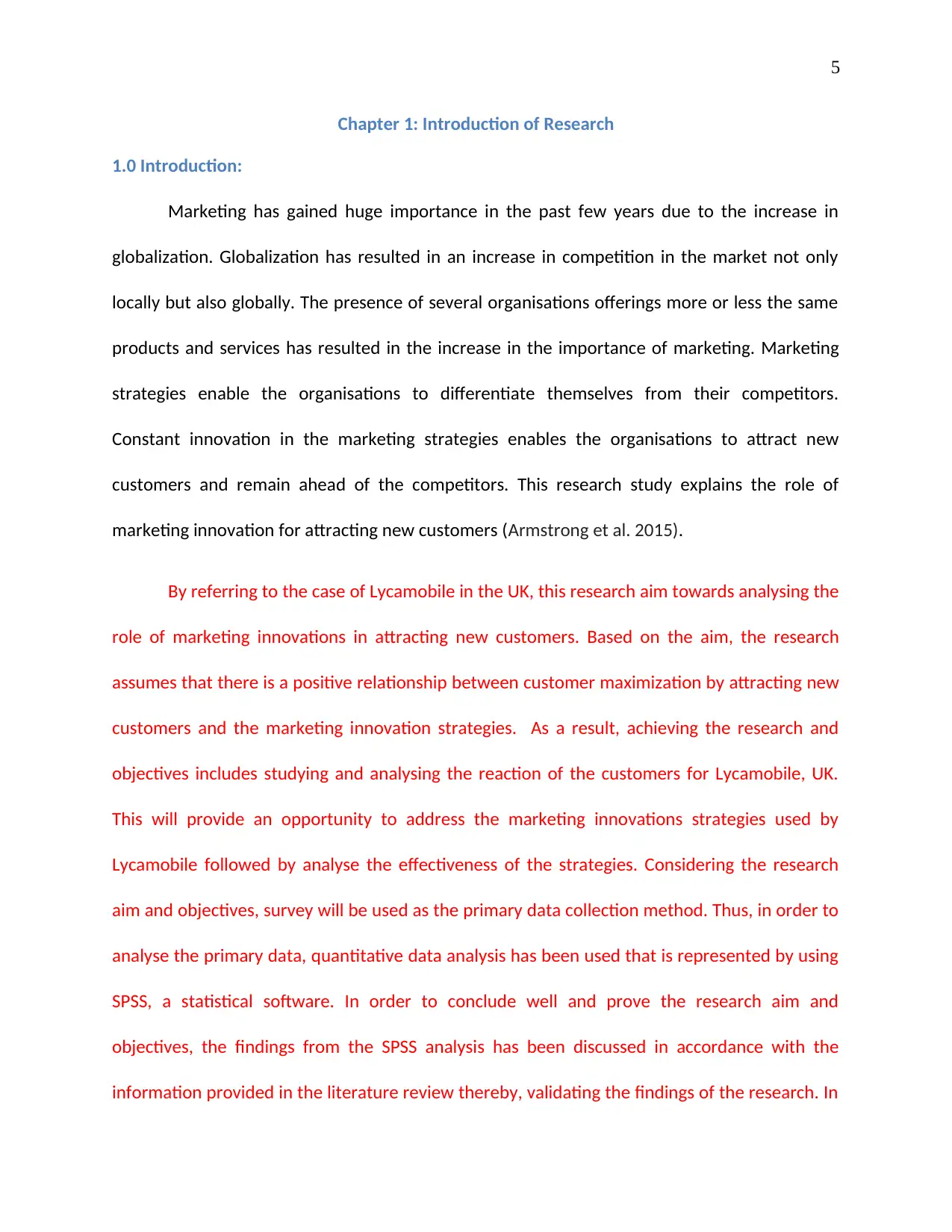
5
Chapter 1: Introduction of Research
1.0 Introduction:
Marketing has gained huge importance in the past few years due to the increase in
globalization. Globalization has resulted in an increase in competition in the market not only
locally but also globally. The presence of several organisations offerings more or less the same
products and services has resulted in the increase in the importance of marketing. Marketing
strategies enable the organisations to differentiate themselves from their competitors.
Constant innovation in the marketing strategies enables the organisations to attract new
customers and remain ahead of the competitors. This research study explains the role of
marketing innovation for attracting new customers (Armstrong et al. 2015).
By referring to the case of Lycamobile in the UK, this research aim towards analysing the
role of marketing innovations in attracting new customers. Based on the aim, the research
assumes that there is a positive relationship between customer maximization by attracting new
customers and the marketing innovation strategies. As a result, achieving the research and
objectives includes studying and analysing the reaction of the customers for Lycamobile, UK.
This will provide an opportunity to address the marketing innovations strategies used by
Lycamobile followed by analyse the effectiveness of the strategies. Considering the research
aim and objectives, survey will be used as the primary data collection method. Thus, in order to
analyse the primary data, quantitative data analysis has been used that is represented by using
SPSS, a statistical software. In order to conclude well and prove the research aim and
objectives, the findings from the SPSS analysis has been discussed in accordance with the
information provided in the literature review thereby, validating the findings of the research. In
Chapter 1: Introduction of Research
1.0 Introduction:
Marketing has gained huge importance in the past few years due to the increase in
globalization. Globalization has resulted in an increase in competition in the market not only
locally but also globally. The presence of several organisations offerings more or less the same
products and services has resulted in the increase in the importance of marketing. Marketing
strategies enable the organisations to differentiate themselves from their competitors.
Constant innovation in the marketing strategies enables the organisations to attract new
customers and remain ahead of the competitors. This research study explains the role of
marketing innovation for attracting new customers (Armstrong et al. 2015).
By referring to the case of Lycamobile in the UK, this research aim towards analysing the
role of marketing innovations in attracting new customers. Based on the aim, the research
assumes that there is a positive relationship between customer maximization by attracting new
customers and the marketing innovation strategies. As a result, achieving the research and
objectives includes studying and analysing the reaction of the customers for Lycamobile, UK.
This will provide an opportunity to address the marketing innovations strategies used by
Lycamobile followed by analyse the effectiveness of the strategies. Considering the research
aim and objectives, survey will be used as the primary data collection method. Thus, in order to
analyse the primary data, quantitative data analysis has been used that is represented by using
SPSS, a statistical software. In order to conclude well and prove the research aim and
objectives, the findings from the SPSS analysis has been discussed in accordance with the
information provided in the literature review thereby, validating the findings of the research. In
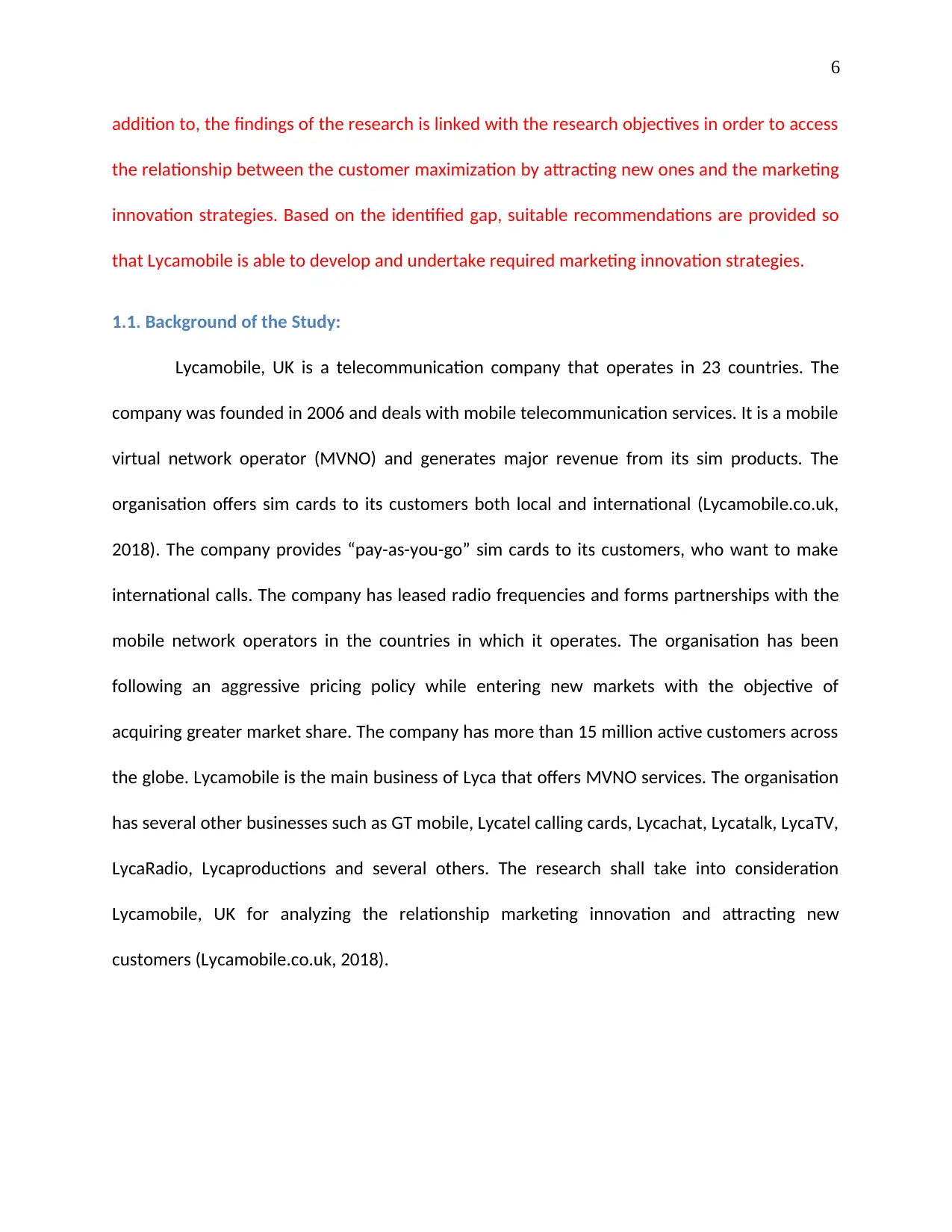
6
addition to, the findings of the research is linked with the research objectives in order to access
the relationship between the customer maximization by attracting new ones and the marketing
innovation strategies. Based on the identified gap, suitable recommendations are provided so
that Lycamobile is able to develop and undertake required marketing innovation strategies.
1.1. Background of the Study:
Lycamobile, UK is a telecommunication company that operates in 23 countries. The
company was founded in 2006 and deals with mobile telecommunication services. It is a mobile
virtual network operator (MVNO) and generates major revenue from its sim products. The
organisation offers sim cards to its customers both local and international (Lycamobile.co.uk,
2018). The company provides “pay-as-you-go” sim cards to its customers, who want to make
international calls. The company has leased radio frequencies and forms partnerships with the
mobile network operators in the countries in which it operates. The organisation has been
following an aggressive pricing policy while entering new markets with the objective of
acquiring greater market share. The company has more than 15 million active customers across
the globe. Lycamobile is the main business of Lyca that offers MVNO services. The organisation
has several other businesses such as GT mobile, Lycatel calling cards, Lycachat, Lycatalk, LycaTV,
LycaRadio, Lycaproductions and several others. The research shall take into consideration
Lycamobile, UK for analyzing the relationship marketing innovation and attracting new
customers (Lycamobile.co.uk, 2018).
addition to, the findings of the research is linked with the research objectives in order to access
the relationship between the customer maximization by attracting new ones and the marketing
innovation strategies. Based on the identified gap, suitable recommendations are provided so
that Lycamobile is able to develop and undertake required marketing innovation strategies.
1.1. Background of the Study:
Lycamobile, UK is a telecommunication company that operates in 23 countries. The
company was founded in 2006 and deals with mobile telecommunication services. It is a mobile
virtual network operator (MVNO) and generates major revenue from its sim products. The
organisation offers sim cards to its customers both local and international (Lycamobile.co.uk,
2018). The company provides “pay-as-you-go” sim cards to its customers, who want to make
international calls. The company has leased radio frequencies and forms partnerships with the
mobile network operators in the countries in which it operates. The organisation has been
following an aggressive pricing policy while entering new markets with the objective of
acquiring greater market share. The company has more than 15 million active customers across
the globe. Lycamobile is the main business of Lyca that offers MVNO services. The organisation
has several other businesses such as GT mobile, Lycatel calling cards, Lycachat, Lycatalk, LycaTV,
LycaRadio, Lycaproductions and several others. The research shall take into consideration
Lycamobile, UK for analyzing the relationship marketing innovation and attracting new
customers (Lycamobile.co.uk, 2018).
⊘ This is a preview!⊘
Do you want full access?
Subscribe today to unlock all pages.

Trusted by 1+ million students worldwide
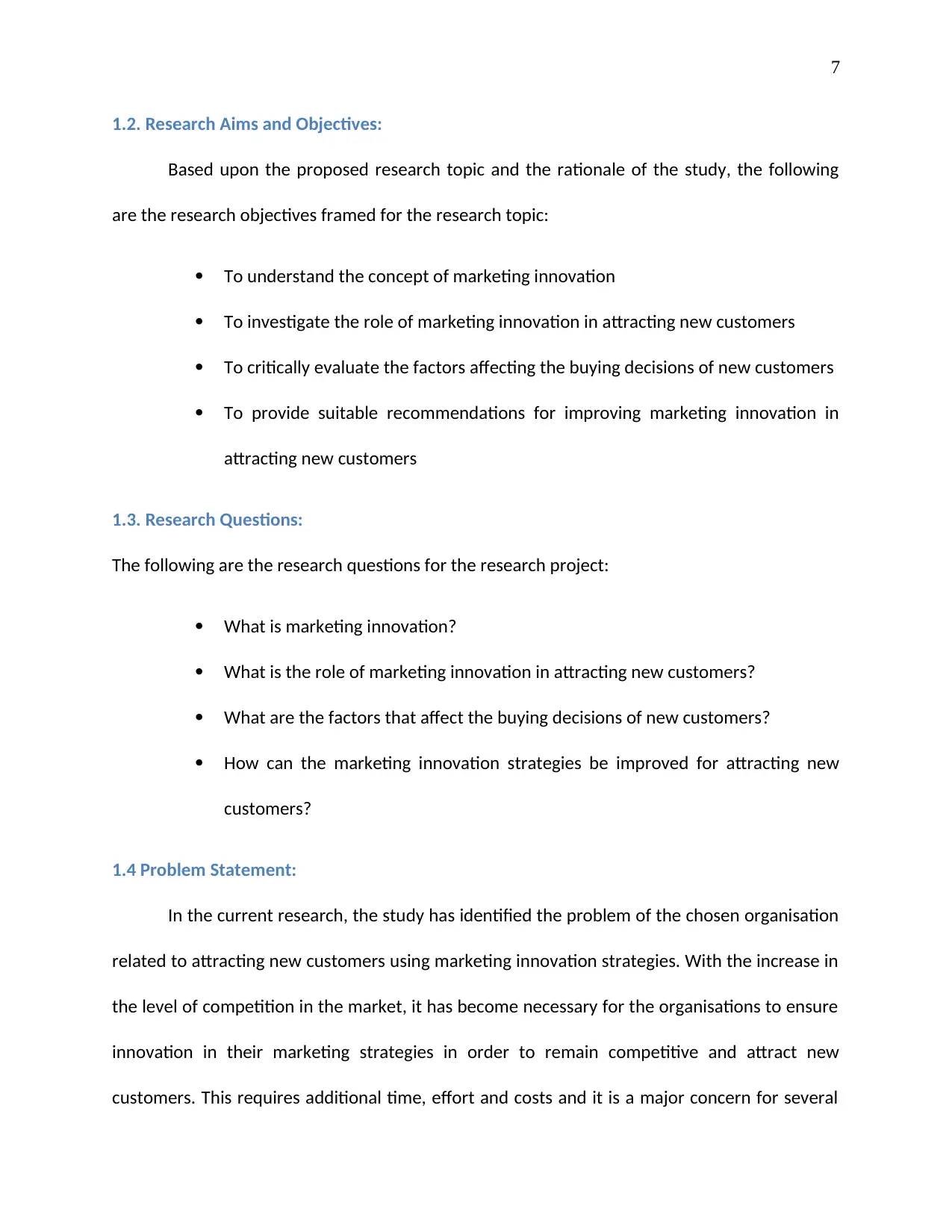
7
1.2. Research Aims and Objectives:
Based upon the proposed research topic and the rationale of the study, the following
are the research objectives framed for the research topic:
To understand the concept of marketing innovation
To investigate the role of marketing innovation in attracting new customers
To critically evaluate the factors affecting the buying decisions of new customers
To provide suitable recommendations for improving marketing innovation in
attracting new customers
1.3. Research Questions:
The following are the research questions for the research project:
What is marketing innovation?
What is the role of marketing innovation in attracting new customers?
What are the factors that affect the buying decisions of new customers?
How can the marketing innovation strategies be improved for attracting new
customers?
1.4 Problem Statement:
In the current research, the study has identified the problem of the chosen organisation
related to attracting new customers using marketing innovation strategies. With the increase in
the level of competition in the market, it has become necessary for the organisations to ensure
innovation in their marketing strategies in order to remain competitive and attract new
customers. This requires additional time, effort and costs and it is a major concern for several
1.2. Research Aims and Objectives:
Based upon the proposed research topic and the rationale of the study, the following
are the research objectives framed for the research topic:
To understand the concept of marketing innovation
To investigate the role of marketing innovation in attracting new customers
To critically evaluate the factors affecting the buying decisions of new customers
To provide suitable recommendations for improving marketing innovation in
attracting new customers
1.3. Research Questions:
The following are the research questions for the research project:
What is marketing innovation?
What is the role of marketing innovation in attracting new customers?
What are the factors that affect the buying decisions of new customers?
How can the marketing innovation strategies be improved for attracting new
customers?
1.4 Problem Statement:
In the current research, the study has identified the problem of the chosen organisation
related to attracting new customers using marketing innovation strategies. With the increase in
the level of competition in the market, it has become necessary for the organisations to ensure
innovation in their marketing strategies in order to remain competitive and attract new
customers. This requires additional time, effort and costs and it is a major concern for several
Paraphrase This Document
Need a fresh take? Get an instant paraphrase of this document with our AI Paraphraser
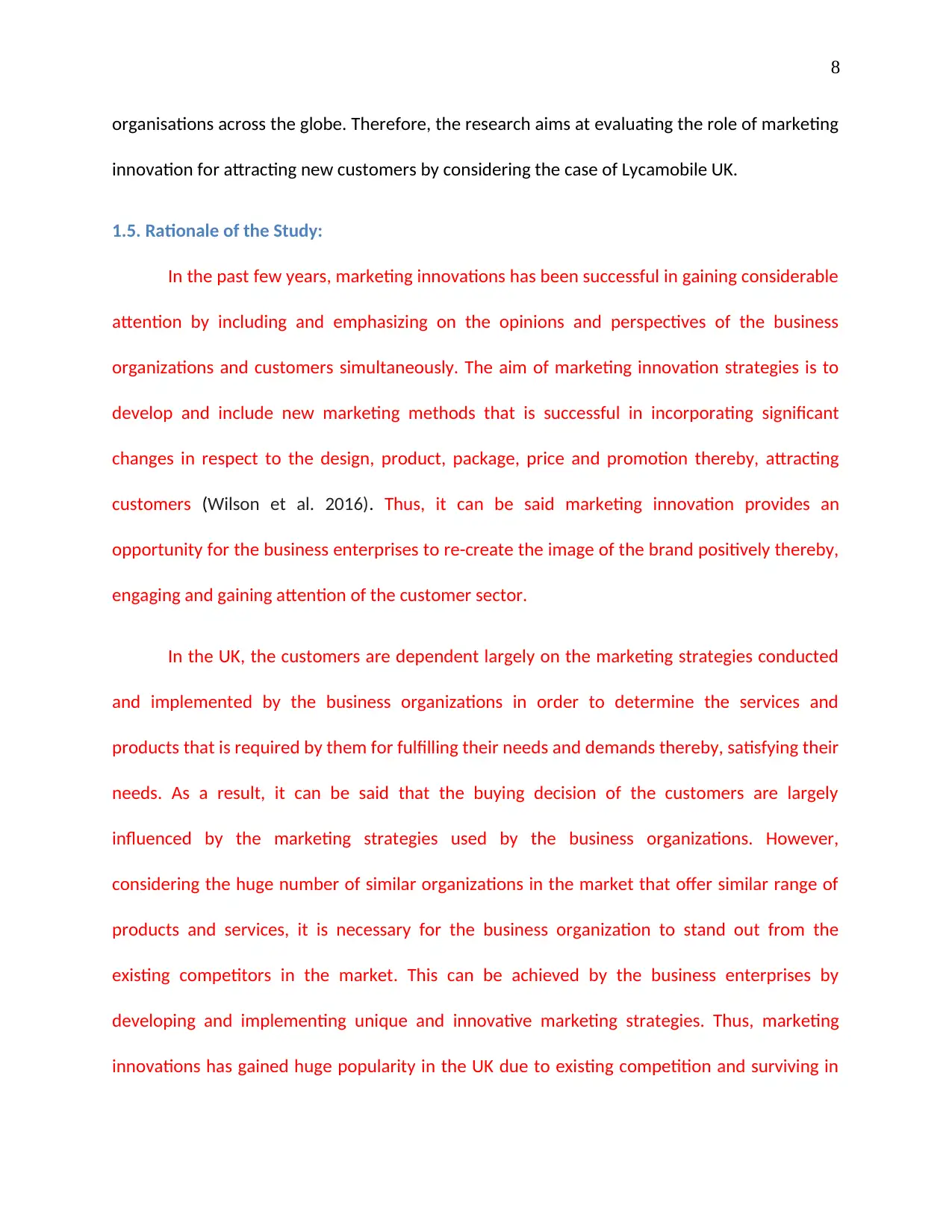
8
organisations across the globe. Therefore, the research aims at evaluating the role of marketing
innovation for attracting new customers by considering the case of Lycamobile UK.
1.5. Rationale of the Study:
In the past few years, marketing innovations has been successful in gaining considerable
attention by including and emphasizing on the opinions and perspectives of the business
organizations and customers simultaneously. The aim of marketing innovation strategies is to
develop and include new marketing methods that is successful in incorporating significant
changes in respect to the design, product, package, price and promotion thereby, attracting
customers (Wilson et al. 2016). Thus, it can be said marketing innovation provides an
opportunity for the business enterprises to re-create the image of the brand positively thereby,
engaging and gaining attention of the customer sector.
In the UK, the customers are dependent largely on the marketing strategies conducted
and implemented by the business organizations in order to determine the services and
products that is required by them for fulfilling their needs and demands thereby, satisfying their
needs. As a result, it can be said that the buying decision of the customers are largely
influenced by the marketing strategies used by the business organizations. However,
considering the huge number of similar organizations in the market that offer similar range of
products and services, it is necessary for the business organization to stand out from the
existing competitors in the market. This can be achieved by the business enterprises by
developing and implementing unique and innovative marketing strategies. Thus, marketing
innovations has gained huge popularity in the UK due to existing competition and surviving in
organisations across the globe. Therefore, the research aims at evaluating the role of marketing
innovation for attracting new customers by considering the case of Lycamobile UK.
1.5. Rationale of the Study:
In the past few years, marketing innovations has been successful in gaining considerable
attention by including and emphasizing on the opinions and perspectives of the business
organizations and customers simultaneously. The aim of marketing innovation strategies is to
develop and include new marketing methods that is successful in incorporating significant
changes in respect to the design, product, package, price and promotion thereby, attracting
customers (Wilson et al. 2016). Thus, it can be said marketing innovation provides an
opportunity for the business enterprises to re-create the image of the brand positively thereby,
engaging and gaining attention of the customer sector.
In the UK, the customers are dependent largely on the marketing strategies conducted
and implemented by the business organizations in order to determine the services and
products that is required by them for fulfilling their needs and demands thereby, satisfying their
needs. As a result, it can be said that the buying decision of the customers are largely
influenced by the marketing strategies used by the business organizations. However,
considering the huge number of similar organizations in the market that offer similar range of
products and services, it is necessary for the business organization to stand out from the
existing competitors in the market. This can be achieved by the business enterprises by
developing and implementing unique and innovative marketing strategies. Thus, marketing
innovations has gained huge popularity in the UK due to existing competition and surviving in
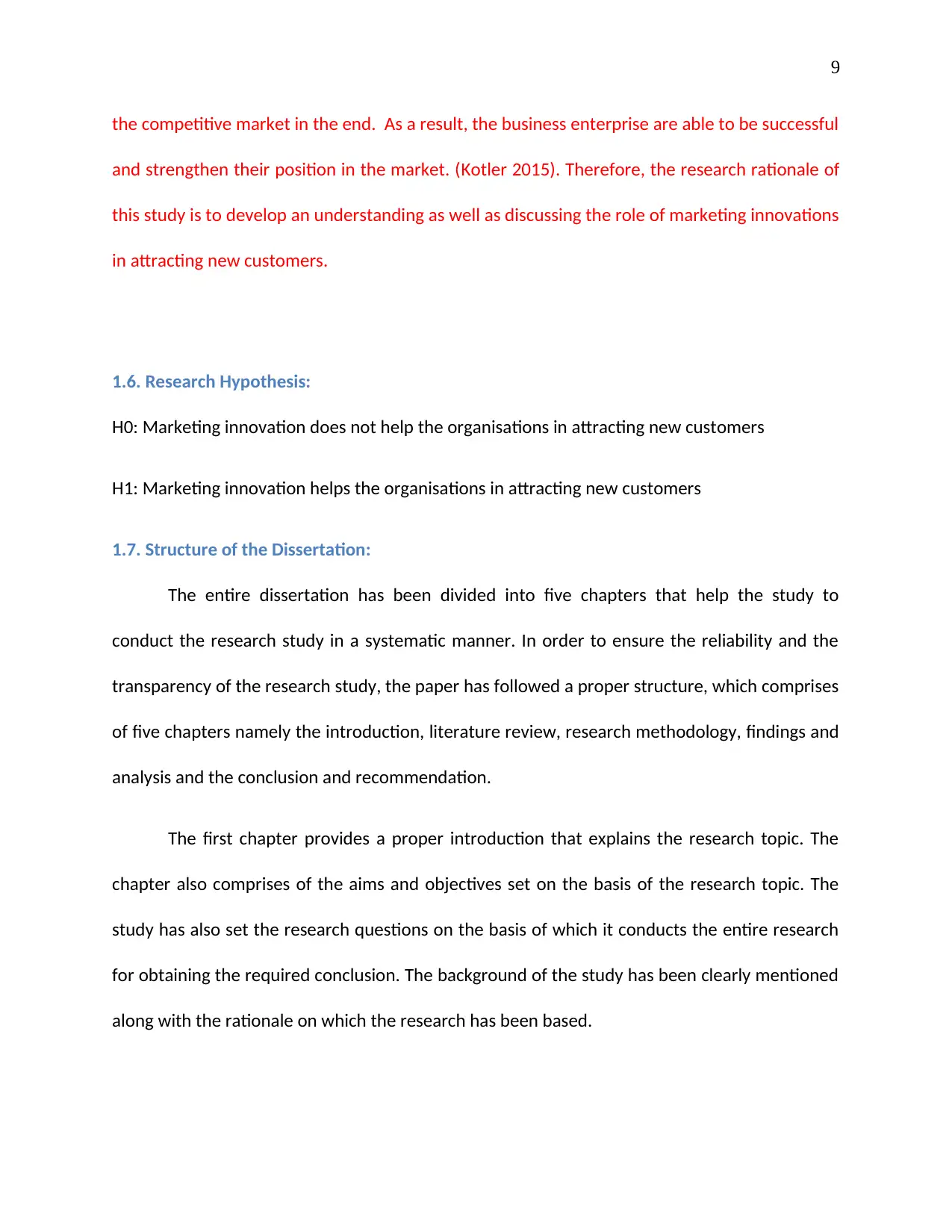
9
the competitive market in the end. As a result, the business enterprise are able to be successful
and strengthen their position in the market. (Kotler 2015). Therefore, the research rationale of
this study is to develop an understanding as well as discussing the role of marketing innovations
in attracting new customers.
1.6. Research Hypothesis:
H0: Marketing innovation does not help the organisations in attracting new customers
H1: Marketing innovation helps the organisations in attracting new customers
1.7. Structure of the Dissertation:
The entire dissertation has been divided into five chapters that help the study to
conduct the research study in a systematic manner. In order to ensure the reliability and the
transparency of the research study, the paper has followed a proper structure, which comprises
of five chapters namely the introduction, literature review, research methodology, findings and
analysis and the conclusion and recommendation.
The first chapter provides a proper introduction that explains the research topic. The
chapter also comprises of the aims and objectives set on the basis of the research topic. The
study has also set the research questions on the basis of which it conducts the entire research
for obtaining the required conclusion. The background of the study has been clearly mentioned
along with the rationale on which the research has been based.
the competitive market in the end. As a result, the business enterprise are able to be successful
and strengthen their position in the market. (Kotler 2015). Therefore, the research rationale of
this study is to develop an understanding as well as discussing the role of marketing innovations
in attracting new customers.
1.6. Research Hypothesis:
H0: Marketing innovation does not help the organisations in attracting new customers
H1: Marketing innovation helps the organisations in attracting new customers
1.7. Structure of the Dissertation:
The entire dissertation has been divided into five chapters that help the study to
conduct the research study in a systematic manner. In order to ensure the reliability and the
transparency of the research study, the paper has followed a proper structure, which comprises
of five chapters namely the introduction, literature review, research methodology, findings and
analysis and the conclusion and recommendation.
The first chapter provides a proper introduction that explains the research topic. The
chapter also comprises of the aims and objectives set on the basis of the research topic. The
study has also set the research questions on the basis of which it conducts the entire research
for obtaining the required conclusion. The background of the study has been clearly mentioned
along with the rationale on which the research has been based.
⊘ This is a preview!⊘
Do you want full access?
Subscribe today to unlock all pages.

Trusted by 1+ million students worldwide
1 out of 100
Related Documents
Your All-in-One AI-Powered Toolkit for Academic Success.
+13062052269
info@desklib.com
Available 24*7 on WhatsApp / Email
![[object Object]](/_next/static/media/star-bottom.7253800d.svg)
Unlock your academic potential
Copyright © 2020–2025 A2Z Services. All Rights Reserved. Developed and managed by ZUCOL.




